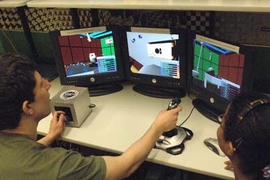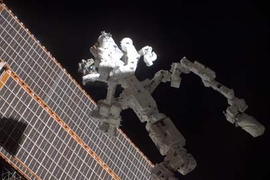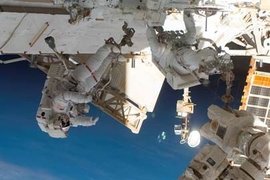The space shuttle's 45-foot robotic arm may look simple and automatic as it gracefully lifts a multi-ton satellite from the cargo bay and lets it drift off into space.
Far from it.
Controlling the spindly arm is a delicate process of manipulating multi-axis joysticks with both hands simultaneously --Â a feat that makes rubbing your stomach while patting your head seem like, well, child's play.
For years, NASA trainers have given astronauts a series of tests before teaching them to control the multi-jointed arm -- an enhanced version of which was attached to the International Space Station during an April shuttle mission. But it turns out they've never checked to see how those test scores relate to the training's outcome.
MIT faculty and graduate students have started to remedy that, by doing a systematic evaluation of the effectiveness of the tests in predicting performance. As they continue a four-year project funded by NASA's National Space Biomedical Research Institute, they will see whether other tests could do better.
Andrew Liu, a research scientist in the Man Vehicle Laboratory, has been leading the project, and began by comparing records of test results and actual performance from 40 astronauts, provided by Johnson Space Center and the Astronaut Office of NASA. Zakiya Tomlinson, a graduate student in the aeronautics and astronautics department, has been running simulation training tests here under the supervision of Liu and Charles Oman, director of MIT's Man Vehicle Laboratory.
Liu presented the first report on the research on May 13 at the Aerospace Medical Association meeting in Boston. The results show "they're not good enough for decisions affecting their career path, but just for things like adjusting schedules," says Tomlinson. "The tests might be suited for selecting training methods, like how many sessions they might need."
Oman explains that "a lot more has been learned in recent years, about the psychological and physical sides of spatial intelligence. People think differently" about such tasks as mentally rotating a complex shape, but NASA's training has not yet adapted in light of new findings.
In NASA's astronaut training, as well as in actual operation of the robot arm in space, astronauts work in pairs with one operating the controls and another observing. In the next round of MIT tests, the training will simulate the role of the observer, Tomlinson explains.
This might help to determine how much of the ability is related to visual skills in spatial orientation, and how much has to do with manual dexterity in operating the controls. With the "observer" training, manual dexterity no longer makes a difference.
Eventually, the research might also lead to better ways of designing the actual control systems and displays to make the process easier and more intuitive to learn and to use, Tomlinson says.
As part of the research, Tomlinson and other team members spent time in Houston working with the actual system used for astronaut training. After she earns her masters degree, "I would love to go back and actually become a trainer," she says.












